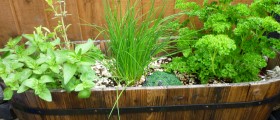Numbness is a deprivation of the ability to move normally or experience sensations in certain body parts fully for periods. It is not a very pleasant feeling. Luckily, some herbs can help relieve numbness.
However, since some of the herbs could potentially have some side effects, consulting a doctor when deciding to treat numbness with them is recommended.

Causes of Numbness
Causes of numbness are most likely to be neurological. Improper functioning of the nervous system could result in numbness of certain body parts. One may also experience pain and itching.
Another probable cause of numbness is leading an insufficiently healthy lifestyle, with an improper diet and not enough exercise.
Finally, lack of oxygen in certain body parts can decrease circulation and provoke numbness. But no matter what the cause or the symptoms are, the right herbs can be quite efficient in these situations.
Still, before taking herbs, one must make sure to consume sufficient amounts of vitamin B and essential fatty acids, as well as introduce regular exercise or any kind of physical activity to the lifestyle. These will even be enough for some people, which means that they may not even need to use the herbs to relieve the symptoms of numbness.
Treatment with Herbal Supplements
Although some people might end up not needing them, the majority of those experiencing the above-mentioned symptoms will most likely require some herbal supplements to make sure that the issues are completely gone.
Anyhow, in case the numbness and other symptoms are the results of some kind of nervous inflammation, the best course of treatment to take is combining two cups of tea made of St. John’s wart, which is a kind of a wild plant, with lavender or skullcap, which is also a type of plant, daily. One herb that has a similar effect is vervain, and it is very successful in getting rid of numbness and spasms. In natural food stores, it can even be bought in the form of a gel.
A more delicious way to deal with numbness of certain body parts is by using peppermint oil. It can awaken the numb areas quite successfully and it should be used just before going to bed for the best results possible.
Finally, when numbness is caused by deficient circulation, a mixture of ginkgo biloba, ginger root, and an herb called Siberian ginseng will most definitely help, not only in improving the circulation but also in boosting the energy levels in the body in general.
- Neuropathic pain may be spontaneous or evoked in response to physical stimuli, that may manifest as increased sensitivity to pain (hyperalgesia) or as a pain evoked by a nonpainful stimuli (allodynia).
- Several types of alterations can induce pathologic activation of central nociceptive neurons: such as neuroplasticity, microglial activation and hyper-excitability (central sensitization) of nociceptive neurons.
- The usage of natural products, principally herbal medicines is one of the ancient therapies used by humanity. During the recent years, people are eager to use herbal medicines due to their lower complications and fewer side effects than synthetic drugs. Regarding to the increasing demand for medicinal plants and related compounds the phytopharmaceutical studies and the use of these remedies for the management of painful neuropathy have been growing throughout the world.
- A. calamus, belongs to Araceae family, it has been used for the management of several inflammatory disorders in Indian traditional medicine. The hydroalcoholic extract of A. calamus (HAE-AC) has been shown to significantly attenuate thermal hyperalgesia, thermal allodynia and mechanical hyperalgesia on neuropathic pain induced by tibial and sural nerve transection (TST) in rats.
- A. scholaris belongs to Apocyanaceae family, it has been used for treating diarrhea, dysentery, malaria, fever and cardiac diseases as well as rheumatic pains in traditional medicine.
- B. monosperma is distributed in deciduous forest and in open areas. It has been used in traditional medicine for various therapeutic effects such as diuretic, anti-diabetic, anthelmintic, antimicrobial, arthritis, wound healing in addition to treating burning sensation of the body.
- C. colocynthis (cucurbitaceae), endemic in Southern Tunisia, in folk medicinal used as an analgesic and anti-inflammatory agents.
- C. sativus commonly known as saffron, belongs to the Iridaceae family and extensively cultivated in Iran and other countries such as India and Greece. It is used traditionally as food and remedy for several disorders including bronchospasm, insomnia, asthma, menstruation problems, pain relief and cardiovascular disorders.
- M. charantia (Cucurbitaceae) grows in Asia, Africa, and Latin America and is used traditionally as food and remedy for several disorders such as asthma and anaemia. Administration of M. charantia significantly attenuated TST induced behavioral alterations including cold, mechanical, and heat hyperalgesia, dynamic mechanical allodynia, and cold allodynia in rats.
- N. sativa is an annual flowering plant belonging to the Ranunculaceae family. It consists of more than 30% fixed oil and 0.4%-0.45% volatile oil. The volatile oil have 18.4%–24% thymoquinone.
- R. officinalis commonly known as rosemary, belongs to Labiatae family. This plant has been used in traditional medicine for several disorders such as dysmenorrhea and rheumatic pain.
- www.medicalnewstoday.com/articles/324572
- www.lybrate.com/topic/numbness
- Photo courtesy of Dick Culbert by Flickr: www.flickr.com/photos/92252798@N07/14125177926
















Your thoughts on this
Loading...